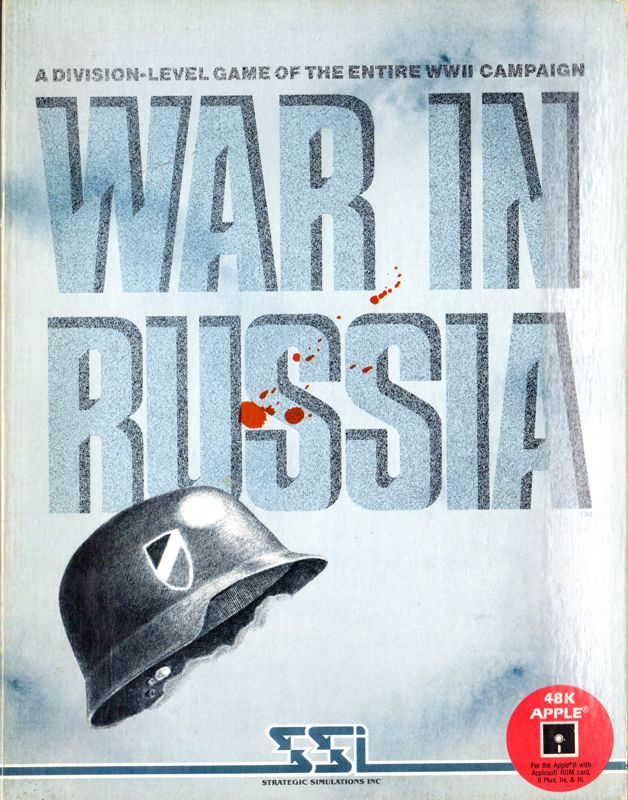
I have been both looking forward and dreading this moment, but I finally reached War in Russia, the first of Gary Grigsby’s monster wargames on the Eastern Front. We have played 4 Grigsby games of increasing complexity thus far, but they were all about specific naval operations in which the number of moving pieces was limited. The scope of those early games, while gigantic for the era, seems restricted compared to modern wargames – but this pattern ends with War in Russia, a monster wargame even by contemporary standards. I will take control of all the German, Romanian, Hungarian, Finnish, Slovakian and Italian forces on the Eastern Front from June 1941 to January 1945. A turn represents one week and is played in more or less 15 minutes, at least at the beginning of the game, so I am here for the long haul.

One of the selling points of the game is that it tracks individual divisions, but thankfully the player mostly manipulates army corps of up to 6 divisions. There are more than 40 corps initially, but this number will grow because the player also manages production, including the production of the heavy factories which themselves build baby vehicles or artillery factories.
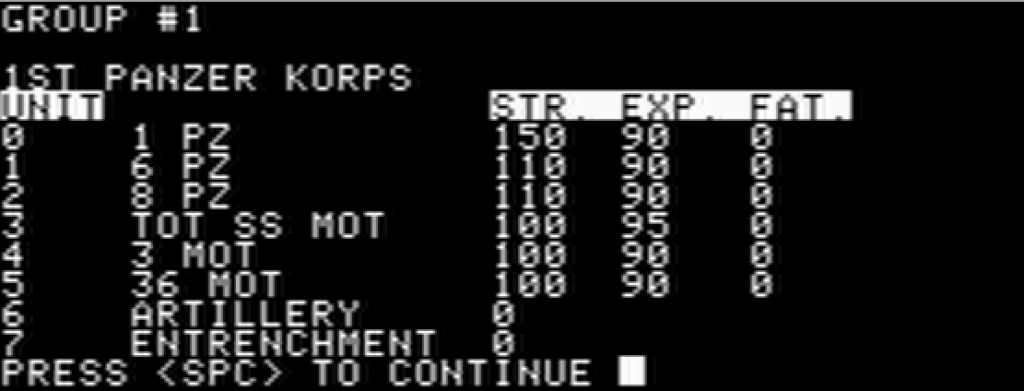
The game starts on the 22nd of June, 1941. The German and Romanian troops are on the border, ready to pounce at the unprepared Soviets:

I have played enough “Eastern Front” games to know that following the historical German plan and going for both Leningrad and Moscow is bound to fail, so I need to choose one. Checking the starting production values, Moscow is important, but not critical for Soviet production: the most important Soviet production centre is the off-map “Urals”, and most of the rest is distributed between the 28 minor cities of the Soviet Union. On the other hand, the game warns about Lend-Lease, and 50% of it will come from either Murmansk (in Winter) and Archangelsk (in Summer).
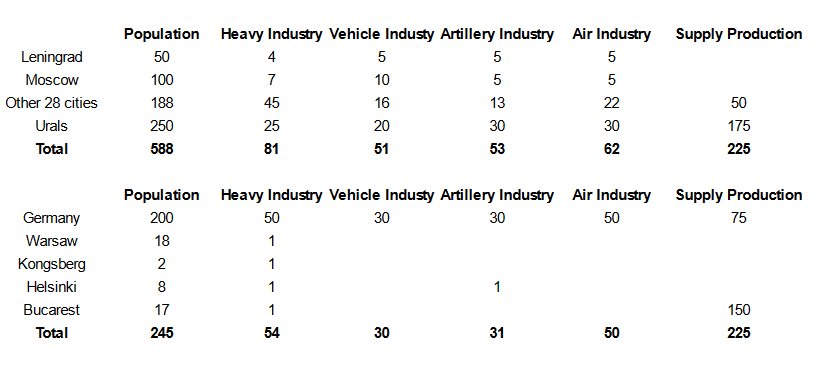
Taking Moscow early has therefore limited strategic value, and I’d rather go all-in on Leningrad. My plan for Leningrad is the historical “Handshake on the Svir” plan: bypass Leningrad by the South, then head North and link up with the Finns near Petrozavod, North of the Svir. Unlike the historical plan, I will commit enough resources to deliver, because I will be totally ignoring Moscow. Effectively, I won’t have an Army Group Center, but then I always found it had the most boring campaigns in the various Panzer General clones.
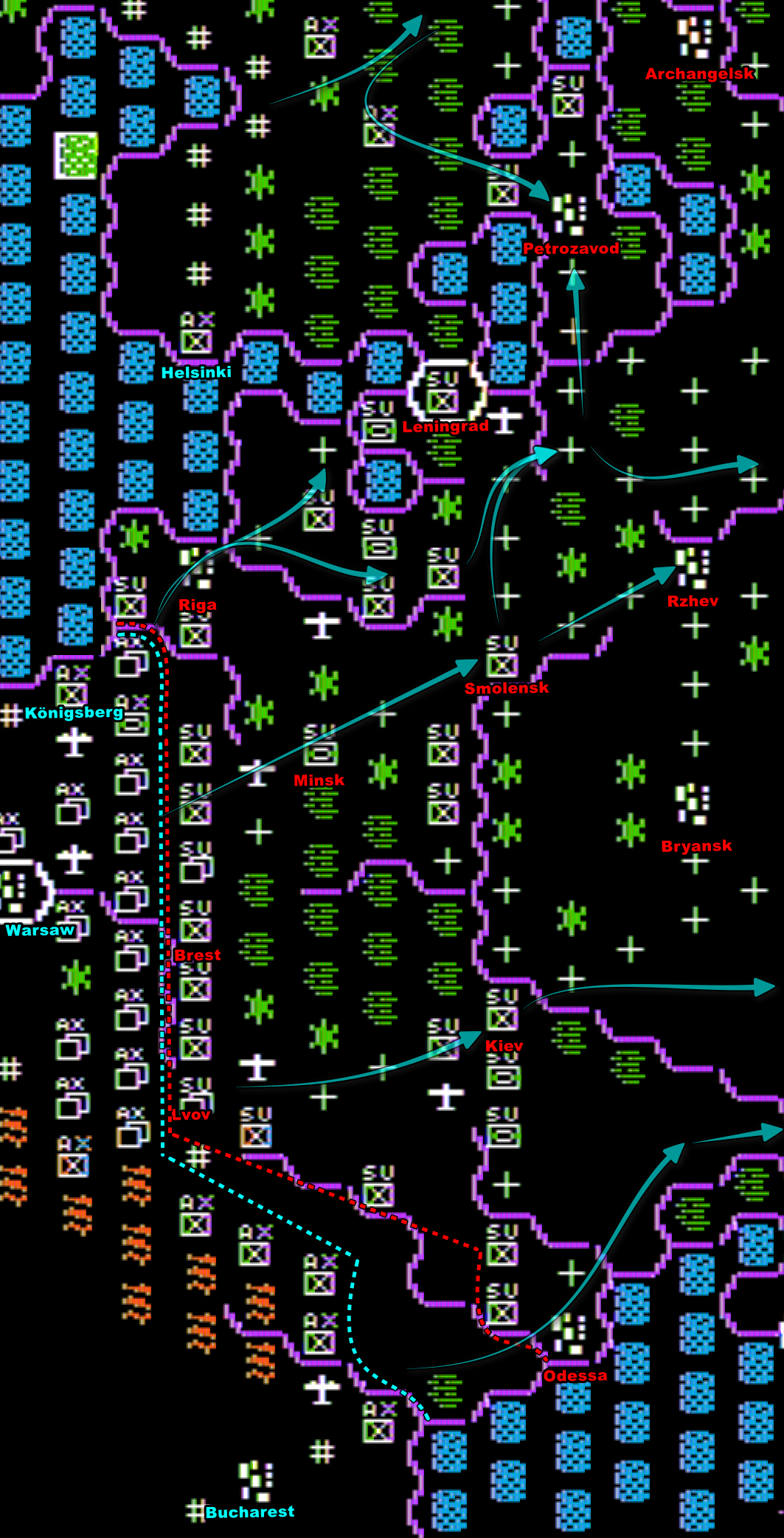
The Southern front is under-prioritized, but then my objectives for 1941 are limited: I want to reach Kharkov and isolate Crimea. I will give myself an extra pat on the back if I manage to also take Kursk. I will rely on mostly infantry, half Romanian half German, and only 2 (small) Panzer Corps. Ah, and also one Italian division. Thank you for the support, Benito.
As for Finland, before going for Petrozavod I will try to take Murmansk to cut the Northern Lend-Lease in Winter.
Summer 1941 – North
Opening the map during the first organisation phase, let me tell you that the Germans are not as ordnunged as you would expect. You see, most of the German Corps don’t start with the maximum of 6 divisions but instead with as few as 2. That would not be an issue if there was not a stacking limit of 2 corps by hexagon, a railroad movement limit of 3 corps by turn or a physical limit to the number of corps that you can supply in a turn. As long as I don’t need to hold a wide front, fewer is better, and I spend some time merging and reordering my units. The Soviets can wait.
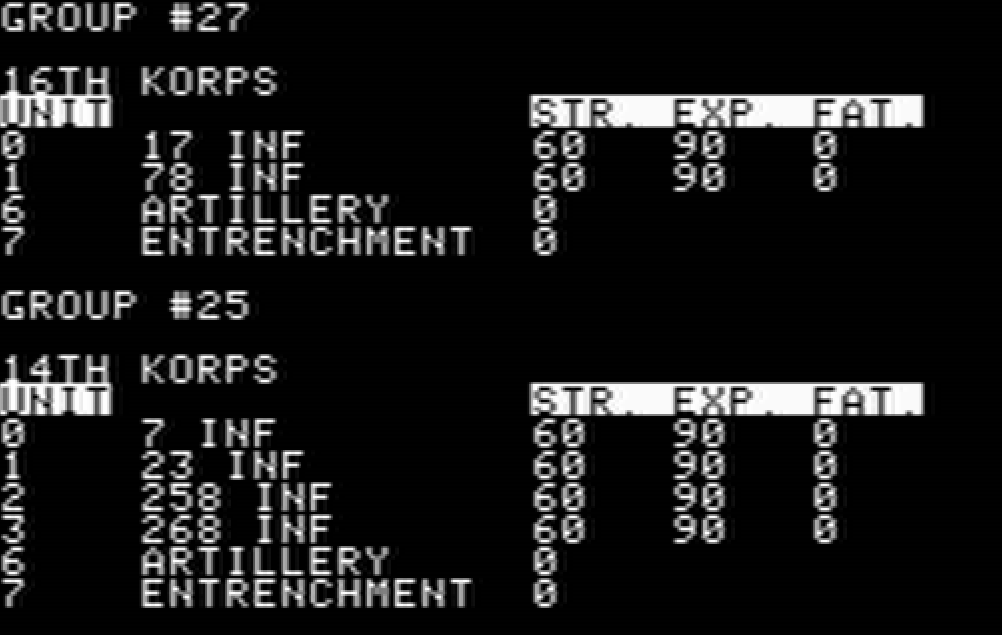
After this reorganisation, the game moves to the supply phase, which I am not going to cover because there are no logistics issues yet, and then to what I could just as well call the conquest phase.
In War in Russia, each month is given a “weather table”, and from July to September the weather table says “Clear: 100%“. There is some chance of rain in June, but it never materialized. Clear weather means that armours fight with a combat bonus on top of their already strong stats and that advancing in clear terrain has almost no fatigue cost. Meanwhile, the Soviet units start small, with low experience and no fortification. In a nutshell, the first part of Summer 1941 is about optimizing movement while brushing the Soviets aside.
The movement phase in War in Russia is weird, with units having to choose between two types of movement: a relatively fast strategic movement that is applied immediately but cannot be used to attack, and a slower and more “fatiguing” tactical movement that can be used to attack or to manoeuvre within an enemy zone of control. As my units start directly in contact with the Soviets, there are a lot more tactical than strategic movements. My forces completely overwhelm the Soviets wherever they engage them, and several Soviet Corps are destroyed as they have nowhere to retreat to:
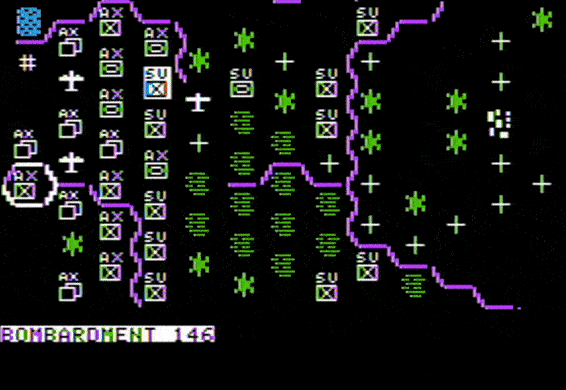
My army easily pierces the Soviet line, and my Panzers dash forward. Riga, Minsk and Smolensk are overrun. By the end of the third week, the Panzers have passed Lake Peipus and are South of Leningrad. The infantry is following shortly behind. I am far away from my logistical base, and the Soviets brought a lot of infantry to delay me, so while it is going well my progress is slowing down. Still, I am on schedule, and the German officers ponder what brand of watch they should wear during the handshake. A B-Uhr would obviously give too much credit to the Luftwaffe, a Junghans would be too plebeian but on the other hand something like a Glashütte could be seen as too frivolous. Maybe a Laco?
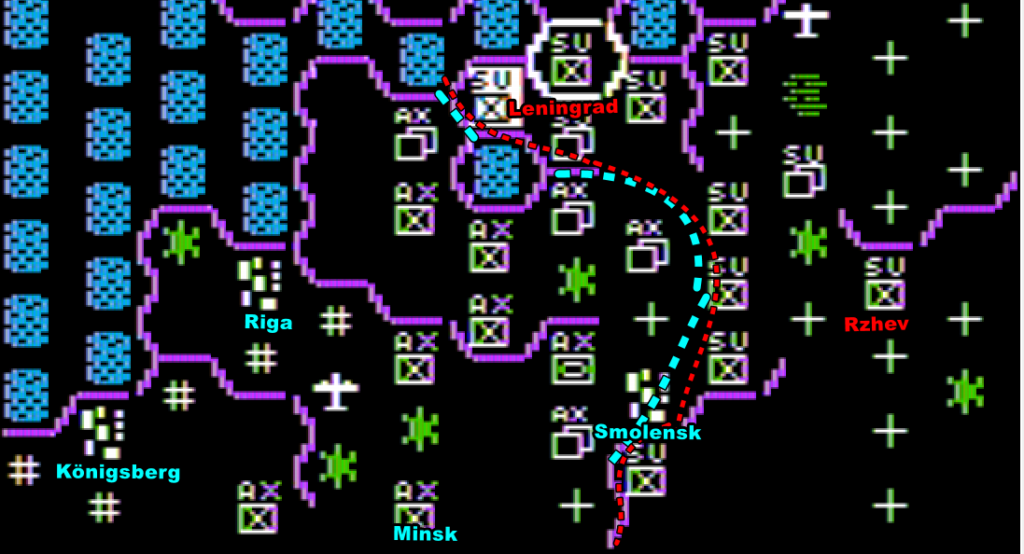
While the Soviets are throwing divisions in my way, they are not counter-attacking, so I feel I can press on. I reach the Svir in the North and the suburbs of Rzhev in the South. I don’t dare go any further in August: my units are exhausted and supplies can’t reach them for now.
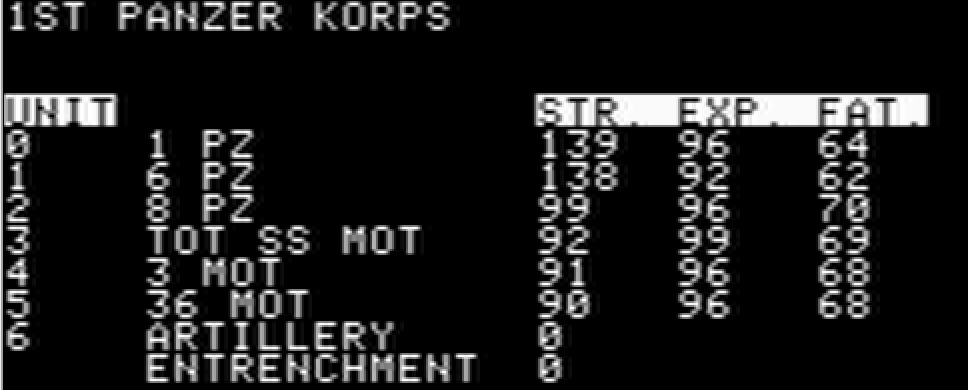
In War In Russia, units accumulate fatigue that can only be removed when they are under supply; being under supply also allows them to receive replacements and to make strategic movements.
At the beginning of each supply phase, I receive 6 depot units (including one in Finland). Those units can only move along axis railroads (“#”) and clear terrain, and cannot enter enemy zones of control. The journeys of the depots end with a “supply distribution”, an action by which the depot (for the turn) to supply all my units within two hexagons away from its location. The more the supply unit has travelled in open terrain (as opposed to railroads), the less fatigue is removed by the supply distribution.
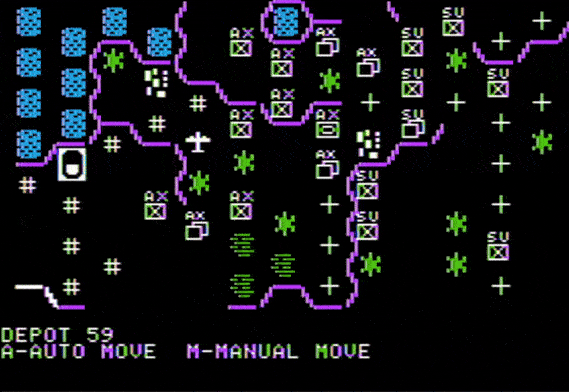
Depots only “exist” during the supply phase.
This means I need to push forward my railroad network so they support my armies, but there is a hard limit: I can only build railroads on one hexagon by turn: in the top half of the map during odd turns, in the bottom half of the map during even turns. I cannot use the Soviet railroads (“+”), I destroy them instead. Cities however are considered as always having a railroad and keep them even after being conquered.
My problem in August is that while my armies could dash forward, my railroad and my supplies needs to zig-zag between forests, and are unable to go beyond Smolensk due to a Soviet unit on the other side of the Dnieper:
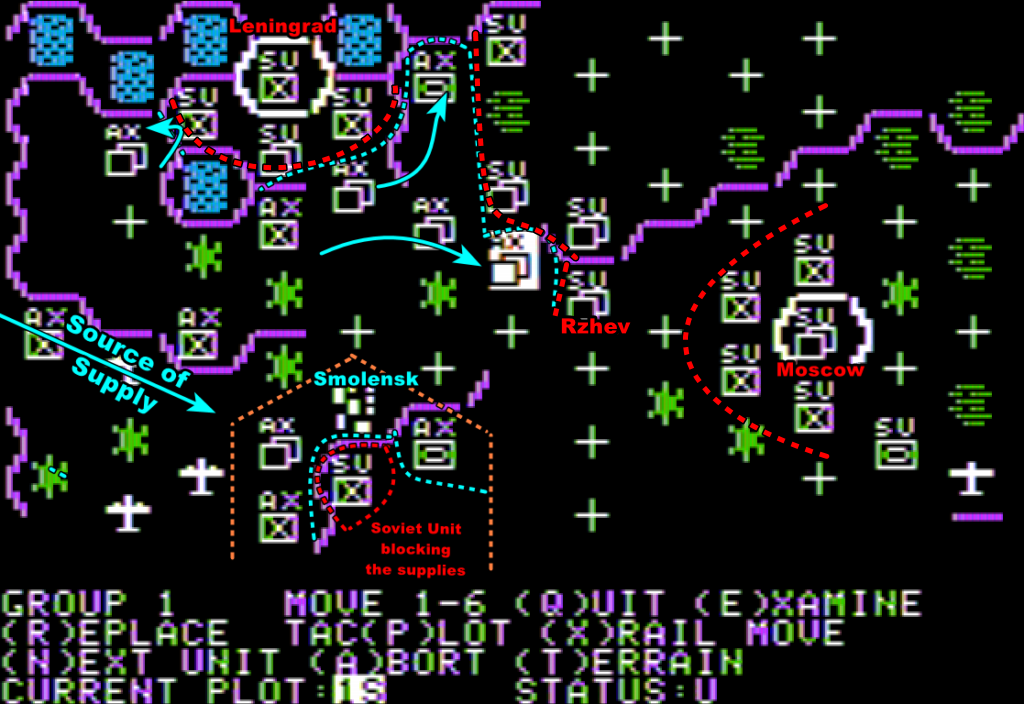
It takes me some time to remove the Soviet infantry blocking the supply route: I have to cross the Dnieper upstream to come from its unprotected side. Meanwhile, my infantry reaches the frontline and even infiltrates without combat through the openings left in the Soviet line.
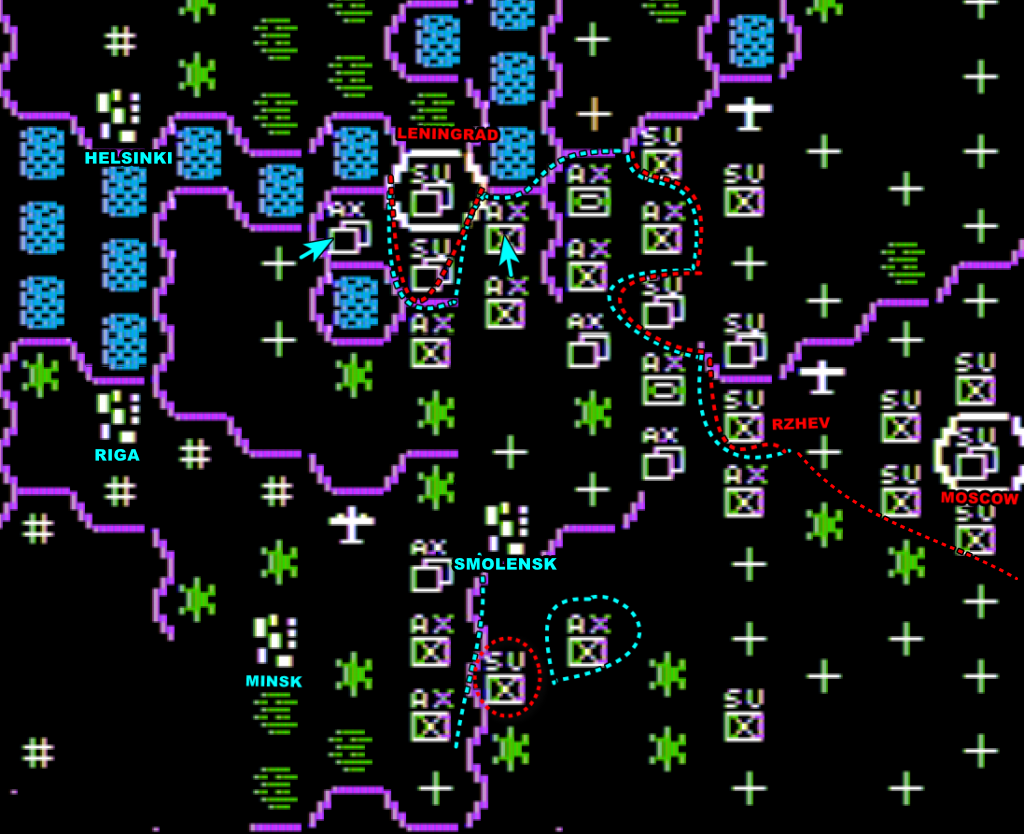
During September, my panzers attack and capture Rzhev and I deploy some divisions South and South-East of Smolensk to make it more difficult for the Soviets to cut my rail lifeline to Germany. I also detach one infantry division to occupy Petrozavod North of the Svir. Germany has done its part, and the officers in Petrozavod have some time to ponder whether they should shave for the handshake. A shaved face may look more professional, but nothing will send a “grizzled veteran” vibe to the Finns better than a bushy beard.
As for the Finns themselves, I spend almost one month merging all the scattered Finnish units into two large ones. I finally cross the border to Eastern Karelia in July, and attack Murmansk in August. It turns out that the garrison is only 2 divisions strong against 12 divisions and a significant chunk of the Luftwaffe brought here specifically for that purpose on my side. The Soviets surrender and Murmansk becomes Finnish. The Finns need to cross Karelia back to resupply, and after that they will head for their rendez-vous with the Germans.
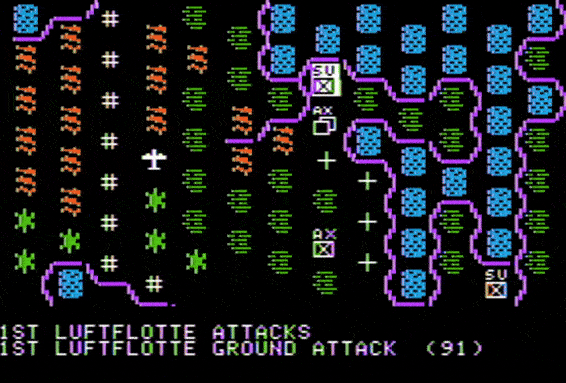
Summer 1941 – South
In the South, the German-Romanian offensive is not quite as decisive. The relative lack of armoured assets and some tactical mismanagement means that the Axis has barely started invading in mid-July, with a significant part of Army Group South is halted several weeks by a well-located Soviet force. By the time the Germans break through and reach Kiev, it has been heavily fortified, and an attack is pushed back with losses. Meanwhile, the Romanians manage to snatch Odessa, but their advance stops until August.
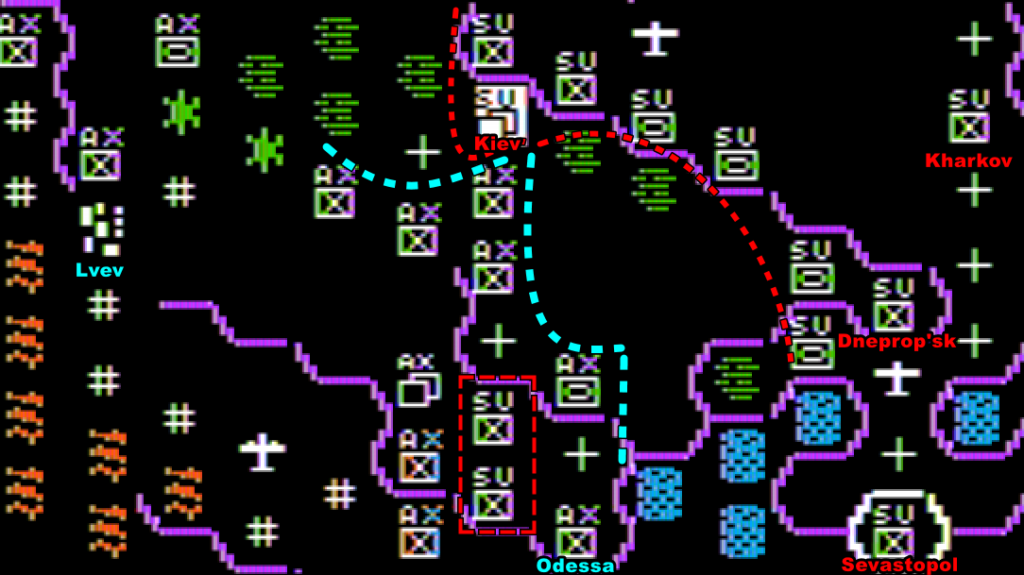
I finally manage to clear Odessa by bringing the German SS motorized division earmarked for Kiev in support. At this point in time, I am afraid I won’t be able to pass the Dniepr before the end of summer. By luck, I cross the last undefended segment of the Dnieper just before the Soviets can bring a unit to cover it. As I try to expand the foothold, I realize that some of the Soviet units in the area are only 1-division strong, allowing me to quickly expand my foothold.
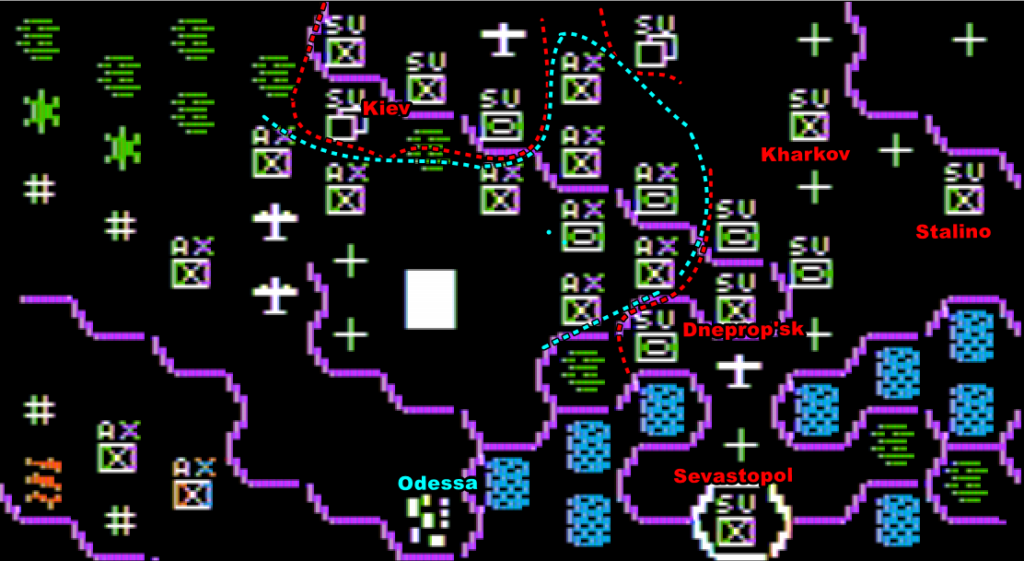
My problems are not over. The most direct route for my railroad would have been through Odessa, but Soviet resistance forced me to run my route from Lvev and pass South of Kiev. By the end of September, it is still very far from where I crossed the Dniepr, so I have very little supply to work with. I reach Kharkov and attack with the hope that it is poorly defended, but it is not and I am pushed back with losses. This is not great, but then it is not the front where the war will be won.
Rasputiza 1941
I know that all operations will have to stop in October 1941, as the weather will turn to rain and the roads to mud. In the last week of September, I detach a few infantry divisions for a few final moves West of Moscow and South of Bryansk. Those divisions are positioned in a way that cuts the supply route from Moscow to Kiev, and I count on the upcoming muddy weather to prevent a counter-attack that would dislodge them.
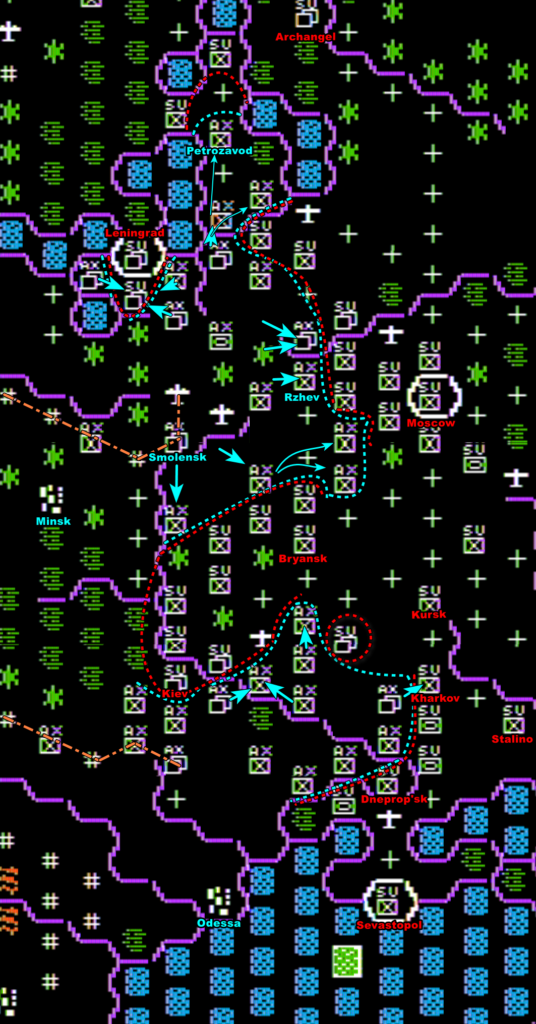
During rainy weather, the fatigue cost of movement is multiplied by 4, which can easily push units beyond the 95-fatigue threshold above which they receive fatigue damage. With such a penalty to moving, there is very little to report in October. I am most surprised by the first Soviet attack of the campaign. It is a limited operation against my one-division Corps South of Bryansk, but it is decisive: my division falls back. And the Soviet supplies can pass through again…
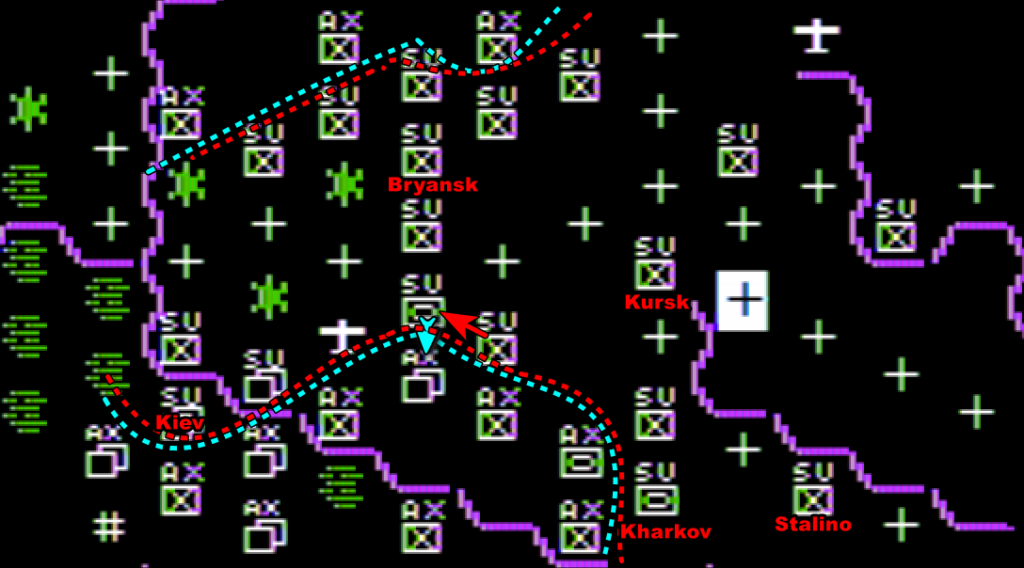
… at least theoretically, because the route to Kiev avoiding my units is somewhat indirect:
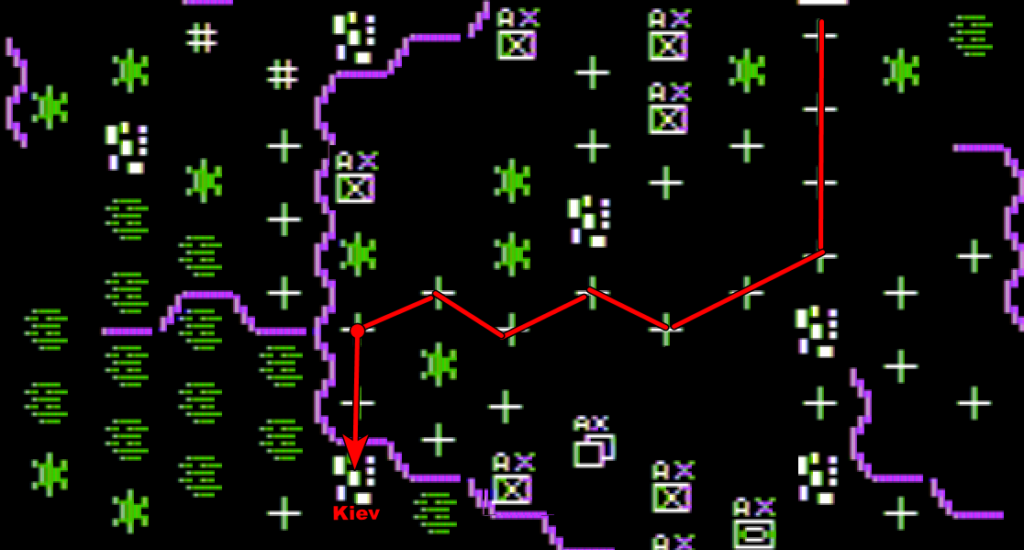
The AI does not “find” this route, as it tries to take the most direct one:

Kiev is still on the menu!
Winter 1941
The ground freezes, and operations can resume – or rather they could if the German Army had winter equipment, but they don’t. Winter has 3 types of weather: Mud (rare), Cold (Common) and Very Cold (Uncommon)… but as an exception in 1941 the “Very Cold” weather happens 80% of the time from December to February.
Cold is bad, and Very Cold is very bad, particularly for the German Army in 1941 and 1942. Here is the nosology of Very Cold weather:
- Fatigue costs of movements jump to x5 base value (only x3 in 1942 and after), so I can’t move any more than I could in October,
- Supply becomes significantly less effective in reducing fatigue,
- Germans armours don’t have their usual attack bonus,
- Bombers have a high chance to encounter “overcast” and cancel their attack,
- Germans attack at 1/4 of their normal value,
- Soviet attacks are twice as effective,
In November, the “Very Cold” weather is still unlikely, but I need my units as fortified and as unfatigued as possible for December, so I am extremely careful. My only movements in November are attacks on Kiev and Leningrad and some operations North of the Volga, all locations where the Soviets cannot counter-attack.
I am right to be careful: there is a Very Cold weather in the middle of the month, and the Soviets use it to go all out:
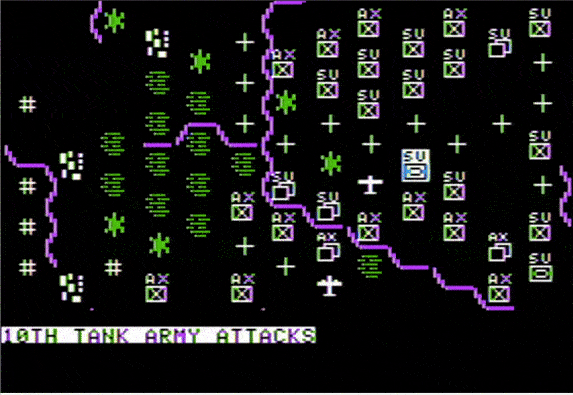
Despite probably more than 15 attacks, the front does not move by one inch – the quality of the Soviet forces is not high yet and I have fortified so much that most of the Soviet attacks are at around 2:1 ratio – not enough. I am lucky with the few attacks that could succeed.
The rest of November is “only” Cold, allowing me to finally capture both Kiev and Leningrad while the Finns remove the Soviet unit next to Petrozavod. The Finns and the Germans have never been closer to a vigorous handshake! It will have to wait a tiny bit though: for now the Finns are too exhausted to move forward ! While waiting for the Finns, a last-minute debate sends the German officers into the throes of indecision: Should they keep their gloves or not? Removing the gloves may be seen as more respectful, but no one likes this weird moment where the other person is waiting in the frost while you struggle to remove your gloves.
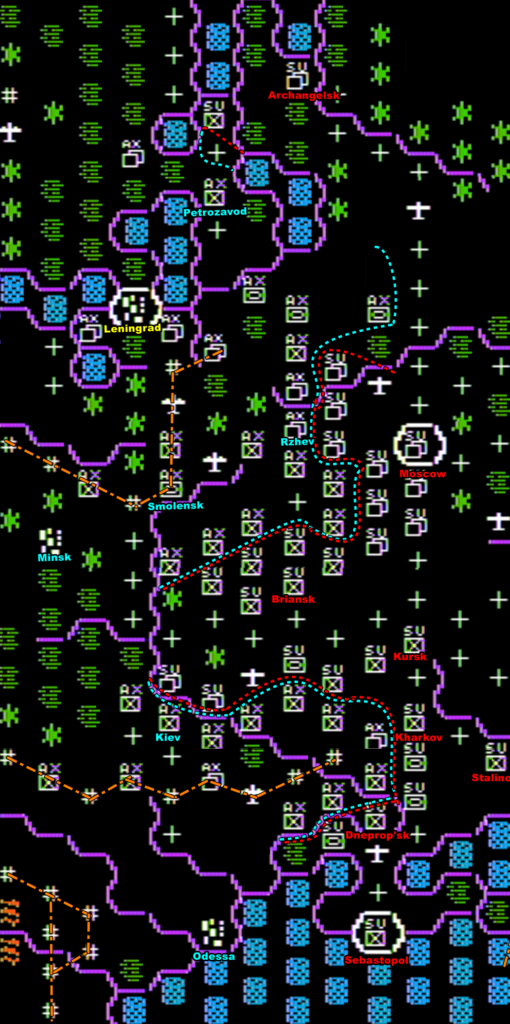
As expected, December immediately starts Very Cold and, as expected, the Soviets go all out again. I resist the first week, but as the freezing temperatures don’t abate I can’t supply my units correctly and my two small corps out of position near Moscow are destroyed.
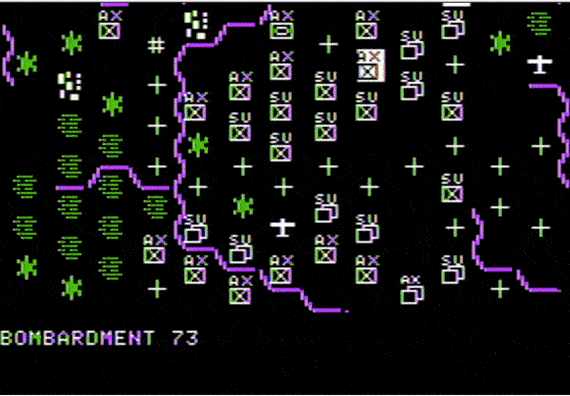
It is not as bad as it sounds – I only lose the strength points value of the divisions inside those corps. In War in Russia, there is no difference in cost between creating a new infantry unit of strength 60 and reinforcing a unit strength 10 to its maximum of strength 70. The lost divisions had some experience points (around 90), but even so, new German divisions in 1941 and 1942 are created with 70 experience points so nothing a couple of combats against the Soviets won’t fix for the new recruits.
I am lucky to get relatively milder weather in the middle of December, which means no attack, and the opportunity to bolster my defence near Moscow with the infantry that had been besieging Leningrad. When the Very Cold weather returns around New Year’s Eve, I am confident my defence is strong: I am well fortified and almost all my units can receive full supply. Still, I have no more respite until the end of February (9 more turns!). Successive attacks slowly destroy the fortifications that my troops had built over time and the Soviets grind some breathing space around Moscow – but my salient of Rzhev holds despite massive attacks coming from 3 directions.
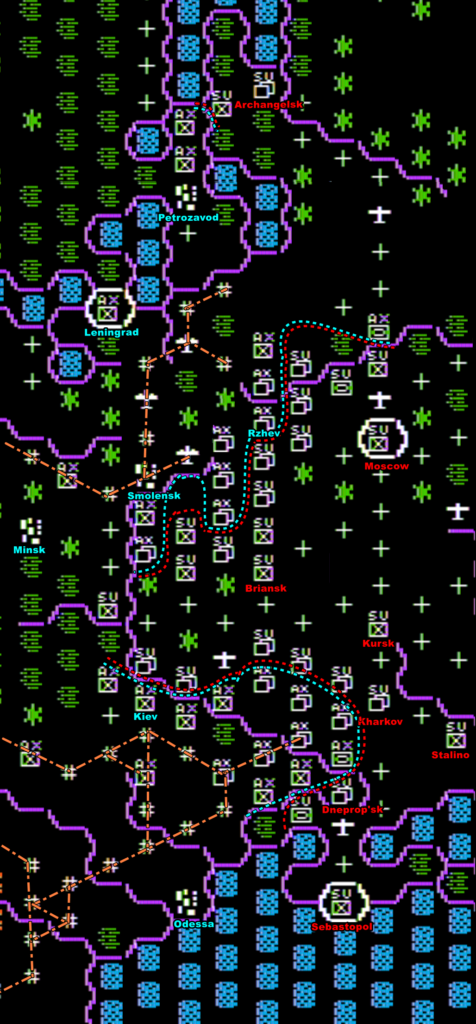
While combats raged around Moscow, Smolensk and Kharkov, the Finns recovered their fatigue, and they moved into Petrozavod. German officers were nervously waiting for them. The Finns had the first word, reminding the Germans to respect their personal space, thank you very much. One meter is adequate, two meters is better. Look, that handshake thing was never to be taken literally.
I completed my ambitious objectives in the North, and resisted the Winter 1941-1942 counter-attack better than expected. I have a shot at taking Moscow in 1942. It won’t be easy though; the Red Army of 1942 will not be the pushover it was in 1941. It has gained a lot of experience in the counter-attacks, and 8 Soviet infantry & cavalry divisions have reached 80 experience and as such been upgraded to “Guards” status. This upgrades their maximum strength from 90 to 120, making them equivalent in capability to the Finnish infantry; no other Axis infantry division, no matter how elite, can pass 100.

Additionally, Soviet tank and motorized divisions in 1941 had a maximum strength of respectively 60 and 90, this maximum moved to respectively 120 and 150 in 1942. The era where I could assume I would win any battle where I commit my Panzers is over.
This has gone on for a while already, so 1942 will be in another article – it should be shorter as I will have a lot fewer rules to explain.